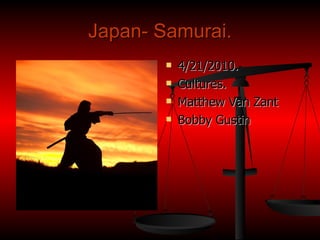Cultures project
- 1. Japan- Samurai. 4/21/2010. Cultures. Matthew Van Zant Bobby Gustin
- 2. Culture of the Samurai. Members of the military Japanese. Japanese warriors. Used weapons such bows and arrows, spears, kamas; most famous weapon is the sword. Lead lives according to ethic code of bushido (way of the warrior). Strongly Confucian in nature, Bushido emphazised concepts such as loyalty to oneâs master, self discipline, respectful, ethical behavior.
- 3. Culture of the Samurai cntâd. After being defeated in battle, some samurai commit seppuku. Seppuku is ritual suicide. This ritual suicide is cutting their abdomen open, rather than being captured or dying dishonorably.
- 4. History of the Samurai: brief summaries through the ages. Heian Period (794-1185) Samurai became important for feuds between clans. Kamakura Period (1192-1303) 1195, Minamoto defeated Taira, and established new military government in Kamakura, 1192. As shogun, (highest military officer) Minamoto Yoritome became ruler of Japan.
- 5. History of the Samurai cntâd. Mariachi Period (1333-1573) During the Chaotic Era (time period) of warring states, (1467-1573), Japan consisted of dozens of independent states which fought each other constantly. Demand for samurai was very high. Between wars, many samurai worked on farms. Many famous samurai movies take place during this era.
- 6. History of the Samurai cntâd. Azuchi-Momoyama Period (1573-1603) Toyotomi Hideyoshi reunited Japan. Introduced rigid social caste system which was completed by Tokugawa Ieyasu and his successors. Hideyoshi forced all samurai to decide between farm life and a warrior life in the castle towns. He forced only samurai to bear swords; no one else could bear swords.
- 7. History of the Samurai cntâd. Edo Period (1603-1868) Samurai stood at top of the social castes followed by farmers, artisans, and merchants. During this time period, all samurai lived in castle towns. Their payment/income was rice.
- 8. History of the Samurai cntâd. Edo Period (1603-1868) cntâd. Masterless samurai were called ronin. Ronins caused minor problems. Fall of Osaka Castle meant that Tokugawaâs last potential rival in governing Japan was eliminated in 1615. Japan had relative peace for 250 years. Martial arts werenât as important as before. 1868, the feudal system got eliminated; no more feudal system. Hence, the samurai class was abolished.







